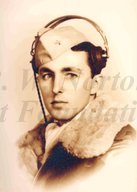
|

|
|
|
|
Raymond was born in Washington D.C., the oldest of two children of Raymond and Marietta Boothby Burgess. In World War I his father served as a mechanic with the 824th Aero Squadron in England. Raymond grew up in Bethesda, Maryland, while his father worked as a mechanic for linotype machines for Washington newspapers. Raymond recalls seeing presidential inaugurations and watching the Bonus March of disenchanted World War I veterans. He caddied and sold newspapers while attending Bethesda Chevy Chase High School. Graduating in 1939, he continued one of his high school jobs of busing tables in the cafeteria of a government building. Raymond was drafted before America entered the war and was sent into the U.S. Army Air Corps. During training at Shepherd Field in Wichita Falls, Texas, Raymond says, "December 7 came along so I never got back home." At Santa Ana, California, working as a trainer in single engine aircraft, he applied for and was accepted into pilot training in Santa Maria, California. Despite a "wash-out" rate of fifty-eight to sixty per cent he earned his wings on November 25, 1942. Still an enlisted man, he was given blue flight officer bars as insignia. (He was finally commissioned while in North Africa.) Raymond was assigned to B-17s in the Twelfth Air Force in Algiers, where he arrived in April of 1943. Placed in the Sixteenth Reconnaissance Squadron, he was stationed at a Royal Air Force base at Blida. He flew night missions at five hundred feet a mile off the coast of Sardinia, Corsica, and Sicily, in which he logged enemy radar and search light transmissions as well as troop strength assessments. They also tested dropping strips of aluminum foil from the bomb bay to confuse enemy radar. Their tests helped to decrease losses of bombers based in England. As German forces were chased from North Africa, Raymond was sent to the eastern part of the country near Tunis. "We operated out of a dirt strip that was literally cut out of the field. We were the only airplane there," he says. He was later transferred to a bomber base at Foggia on the eastern coast of Italy, where he flew missions into northern Italy to track the enemy's searchlight frequencies and gun lanes. "We'd just circle," he says. "It might take twenty or thirty minutes. Our guys back there in the radio compartment were logging that stuff." Raymond finished fifty missions and got orders for home in July of 1943. After a thirty-day leave he reported to the base at Alexandria, Louisiana, as a B-17 instructor. He met Sylvia Sepulvado in Alexandria's Bentley Hotel and married her on March 18, 1945. They would have three sons and a daughter. He next worked in a B-29 flight test section at Kearney Air Force Base in Nebraska. After the war he was stationed in Vienna, Austria, but returned at Christmas in 1945. He was discharged, worked for a mortgage loan company in Alexandria, and then re-entered the Air Force. He was assigned as a B-29 co-pilot at Barksdale Air Force Base. He served in Korea, and flew B-47 and B-52 aircraft in the states. Raymond retired from the Air Force in 1969. |


